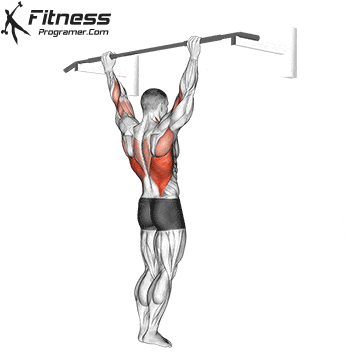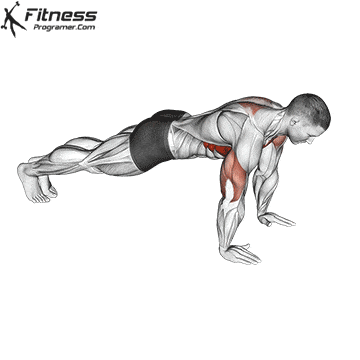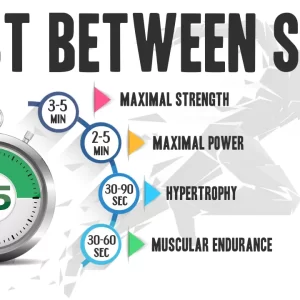Contents
By following this 8-week workout routine, you will embark on a transformative journey that increases your endurance, strength and overall conditioning. Aerobic activities, like jogging, enhance cardiovascular health and endurance, while anaerobic exercises, such as pull-ups, push-ups, and squats, target muscle strength and explosive power. Combining both creates a synergy that maximizes your fitness potential. Get ready to sweat, challenge yourself, and become the best version of you!
Purpose of the Workout:
The primary goal of this fitness program is to achieve a perfect balance between running, pull-ups, push-ups, and squats, reaping the benefits of both cardiovascular endurance and muscle strength. This holistic approach ensures that you develop not only physical strength but also mental resilience.
Benefits of an 8-Week Workout Routine
Embarking on an 8-week workout offers a multitude of benefits that can positively impact your physical health, mental well-being, and overall quality of life. Here are some key advantages of committing to such a program:
- Improved Cardiovascular Health: Regular exercise, particularly aerobic activities like running, enhances your heart and lung health. It strengthens your heart, lowers blood pressure, and improves circulation, reducing the risk of cardiovascular diseases.
- Increased Endurance: An 8-week workout program challenges your endurance and stamina. Over time, you’ll find yourself able to sustain physical activity for longer durations without fatigue.
- Enhanced Strength: Incorporating strength training exercises such as pull-ups, push-ups, and squats helps build lean muscle mass. Increased muscle strength improves overall functional fitness and makes daily activities easier.
- Weight Management: Combining aerobic and anaerobic exercises aids in calorie burn and fat loss. As you progress through the program, you’ll likely notice positive changes in your body composition.
- Boosted Metabolism: Building lean muscle through strength training can lead to an elevated resting metabolic rate. This means you’ll continue to burn calories even when you’re not working out, supporting long-term weight management.
- Enhanced Mood: Exercise triggers the release of endorphins, which are natural mood lifters. Engaging in regular physical activity can help reduce stress, anxiety, and symptoms of depression.
- Increased Energy Levels: Regular exercise boosts energy levels and reduces feelings of fatigue. You’ll find yourself more alert and productive throughout the day.
Remember that the benefits of an 8-week workout program are not limited to the duration of the program itself. Establishing a consistent exercise routine during these eight weeks can set the stage for a lifetime of improved health and well-being.
The Benefits of Aerobic and Anaerobic Training:
To maximize your fitness journey, it’s crucial to understand the advantages of both aerobic and anaerobic training.
Aerobic Training:
- Improves cardiovascular health.
- Increases stamina and endurance.
- Burns calories for weight management.
- Boosts overall energy levels.
Anaerobic Training:
- Builds muscle mass.
- Elevates metabolism for long-term fat loss.
- Enhances strength and power.
- Improves bone density.
Blending Aerobic and Anaerobic Activity:
- Running improves cardiovascular health, burns calories, and increases endurance.
- Pull-ups target your upper body, particularly the back, biceps, and shoulders.
- Push-ups strengthen your chest, triceps, and core.
- Squats work your lower body, engaging your quads, hamstrings, and glutes.
Our 8-week workout routine is designed to harness the benefits of both aerobic and anaerobic exercises. By combining running (aerobic) with pull-ups, push-ups, and squats (anaerobic), you’ll experience a holistic fitness transformation.
8-Week Workout Regimen
By the end of the 8-week training program, your objective is to accomplish 10 circuits, each comprising a 500-meter run, 10 pull-ups, 20 push-ups, and 20 squats. This achievement will signify significant progress in your endurance, strength, and overall fitness.
Running | 500m |  |
Pull-up | 1×10 |  |
Push-up | 1×20 |  |
Bodyweight Squat | 1×20 |  |
How to Start an 8-Week Workout
Circuits will consist of four exercises performed in a specific order with no or minimal rest in between. You’ll start with a 500-meter jog, priming your body for action. Next, you’ll complete half of the maximum pull-ups you can perform without rest, followed by half of the push-ups and bodyweight squats you can execute.
For example, if you can do 10 pull-ups, 20 squats, and 20 push-ups in one go, you’ll aim for 5 pull-ups, 10 squats, and 10 push-ups after each 500-meter jog.
For Beginners:
Start with a 500-meter jog to kick off the circuit, focusing on maintaining a steady pace. If you’re just starting out, you might need more rest initially. As you progress, aim to reduce rest times to make your workouts more challenging.
The key is to start at a level that challenges you but is manageable, and then gradually increase the intensity as your strength and endurance improve over time. This approach allows beginners to build up their fitness gradually and avoid overexertion or injury. Remember to listen to your body and adjust the routine as needed to ensure your safety and progress.
Advanced: 15 round (500m run + 10 pull-up + 20 push-up + 20 Squat)
Progression and Frequency:
- Aim to do this workout program two to three times a week.
- If you are incorporating weight training, limit this circuit-style workout to just one day a week.
- Focus on gradual progression by increasing the number of repetitions each week.
- Ensure you’re increasing the intensity gradually to avoid overtraining or injury.
- Track your progress and adjust the workout as needed to challenge yourself appropriately.
- Allow sufficient rest between sessions, especially if you are combining this circuit with weight training. Proper rest and recovery are crucial for muscle growth and overall performance.
Nutrition:
Eating a balanced diet with sufficient nutrients is crucial to support your training. Ensure you’re getting enough protein for muscle recovery and carbohydrates for energy. Hydration is also essential, so drink plenty of water throughout the day.
Warm-Up and Cool-Down:
Include warm-up and cool-down routines in each workout session. A proper warm-up helps prepare your body for exercise, while a cool-down aids in recovery and reduces the risk of injury. Dynamic stretching and light aerobic activities make excellent warm-up choices, while static stretching and deep breathing can be part of your cool-down.
Configuring an 8-Week Workout Routine for Beginners
Week 1:
- 500 meters running
- 4-5 pull-ups
- 10 push-ups
- 10 squats
- Aim for 2-3 circuits
In the first week, you’ll begin with a 500-meter run to lay the groundwork for cardiovascular fitness. This run will help you build stamina gradually. You’ll also perform 4-5 pull-ups, targeting your back and arm muscles, 10 push-ups to strengthen your chest, shoulders, and triceps, and 10 squats, engaging your legs and glutes. Your goal is to complete 2 to 3 full circuits during this week to establish the routine, focusing on maintaining proper form and consistency.
Week 2:
- 500 meters running
- 6-7 pull-ups
- 12-14 push-ups
- 12-14 squats
- Aim for 3 or more circuits
In the second week, your 500-meter run remains consistent to continue improving cardiovascular endurance. The number of pull-ups increases to 6-7 repetitions, challenging your upper body strength and gradually improving your ability to perform more repetitions. Both push-ups and squats also increase to 12-14 repetitions each, offering increased resistance for your upper and lower body. Your target for this week is to aim for 3 or more circuits, which will further challenge your stamina and strength.
Week 3:
- 500 meters running
- 7-8 pull-ups
- 14-16 push-ups
- 14-16 squats
- Aim for 4 or more circuits
Continuing with the 500-meter run, you’ll now be accustomed to the cardiovascular component of the workout. Pull-ups increase to 7-8 repetitions, requiring greater upper body strength. Push-ups and squats also intensify to 14-16 repetitions each, testing your muscular endurance. Your goal for this week is to aim for 4 or more circuits, emphasizing the development of both strength and stamina.
Week 4:
- 500 meters running
- 9-10 pull-ups
- 16-18 push-ups
- 16-18 squats
- Aim for 5 or more circuits
Here, you’ll confront a heightened challenge with 9-10 pull-ups, requiring substantial upper body strength and endurance. The repetitions for push-ups and squats increase to 16-18, pushing your boundaries regarding muscular stamina. Your objective for this week should be to complete at least 5 circuits, marking your progress as you approach the program’s culmination, highlighting the substantial gains in strength and endurance you’ve achieved.
Week 5 to 8:
- 500 meters running
- 10 pull-ups
- 20 push-ups
- 20 squats
- Focus on increasing the number of circuits as much as possible during this period
During the remaining weeks, the 500-meter run remains a stable element, allowing you to gauge your progress in cardiovascular fitness. You’ll consistently perform 10 pull-ups, emphasizing upper body strength and endurance. Push-ups and squats will stay at 20 repetitions each, further strengthening your upper and lower body. Throughout this phase, your primary focus should be on increasing the number of circuits as much as possible. This will push your boundaries and steadily enhance your overall fitness, making it an ideal continuation for your fitness journey.
The Bottom Line
This circuit-style training routine will help you progressively build endurance, strength, and conditioning over the 8-week period, ensuring that you continue to challenge yourself and see improvements in your fitness levels. If you have any underlying health concerns or are new to exercise, it’s a good idea to consult with a healthcare professional or fitness trainer before starting any workout program.
References
- Int J Exerc Sci. 2016; The Relationship Between Aerobic and Anaerobic Performance in Recreational Runners PMCID: PMC5154721
- Gäbler M., Prieske O., Hortobágyi T., Granacher U. The Effects of Concurrent Strength and Endurance Training on Physical Fitness and Athletic Performance in Youth
- Rønnestad B.R., Mujika I. Optimizing strength training for running and cycling endurance performance: A review. Scand. J. Med. Sci. Sports. 2014; PMID: 23914932



